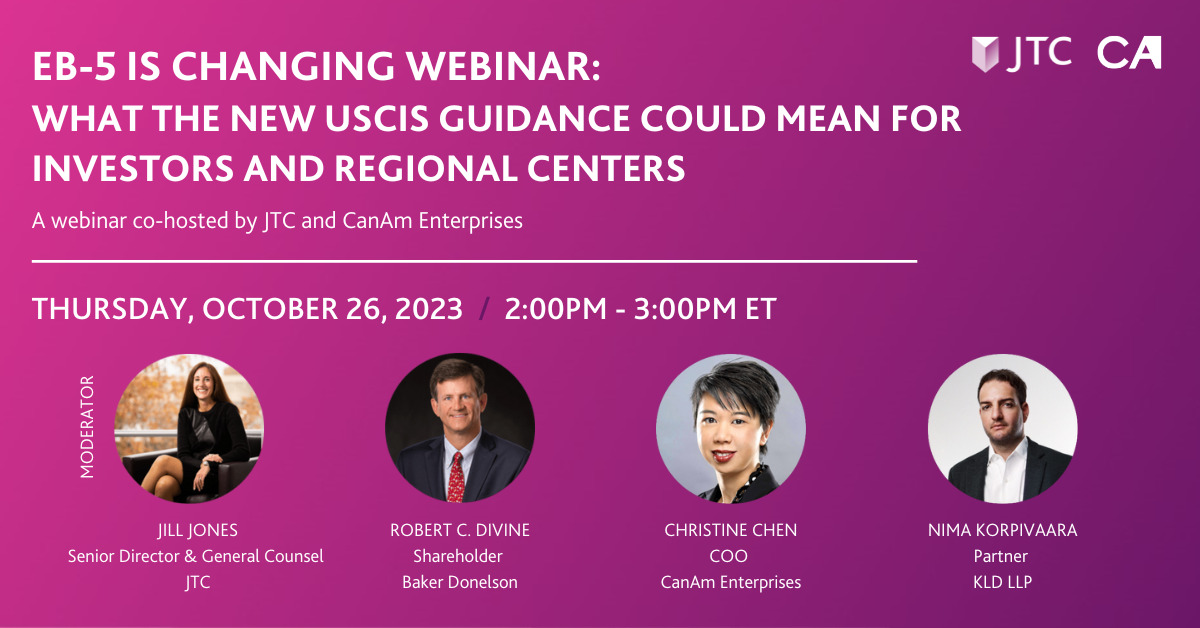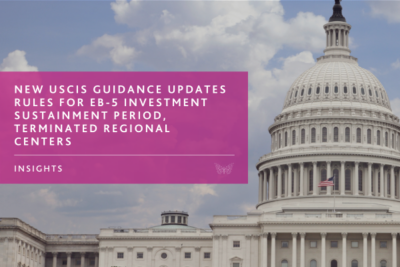Deep Dive: Consular Processing and Adjustment of Status
The EB-5 immigrant investor program is a dynamic and evolving pathway to U.S. permanent residency, particularly since the passage of the EB-5 Reform and Integrity Act in 2022. With faster processing times and increased approvals of I-526E petitions, investors are finding more certainty in their immigration journey. However, as Nick Buonagurio, Senior Vice President of Business Development at CanAm, and Christian Triantaphyllis, Partner at Jackson Walker LLP, discussed in their recent webinar, petition approval is just the first step. The next stage—either consular processing or adjustment of status—can significantly impact an investor’s timeline and experience.
Understanding Consular Processing
For EB-5 investors outside the United States, consular processing is the required step after receiving I-526E petition approval. Once the petition is approved, USCIS forwards the case to the National Visa Center (NVC), which then issues a visa fee bill and a welcome letter. Investors must complete and submit the DS-260 application along with civil documents such as birth certificates, marriage certificates, and police clearance certificates.
“The timeline on getting that notice has been differing between those who filed before the EB-5 Reform and Integrity Act and those who filed after,” noted Triantaphyllis. “For pre-reform applicants, we’ve seen waits as long as six months, whereas post-reform applicants often receive the visa fee bill within two to three months.”
Once the NVC deems the applicant “documentarily qualified,” it works with the U.S. consular post in the investor’s home country to schedule an EB-5 visa interview. Timelines vary depending on the consulate, with high-volume posts like Mumbai, Guangzhou, and Ho Chi Minh City sometimes taking six to nine months to schedule interviews.
At the consular interview, investors must provide passports, their DS-260 confirmation, and medical examination records. As Triantaphyllis advised, “Be prepared to discuss the status of your EB-5 investment and project, but don’t stress about memorizing every job creation number—just speak confidently about your investment and immigration goals.”
Following a successful interview, the investor receives their EB-5 visa, an immigrant packet, and instructions for entering the U.S. Once admitted, they will receive their two-year conditional green card within approximately 90 days.
The Benefits of Adjustment of Status (AOS)
For EB-5 investors already in the United States on valid non-immigrant visas, adjustment of status (AOS) presents a powerful advantage. Thanks to the 2022 reform, investors can now file their I-526E petition and I-485 AOS application concurrently, allowing them to remain lawfully in the U.S. while their green card is processed.
“We’re seeing a significant increase in U.S.-based investors utilizing AOS,” said Buonagurio. “This option provides work and travel authorization within months of filing, rather than waiting years for an I-526E approval before beginning the consular process.”
With concurrent filing, investors also submit Form I-765 for work authorization and Form I-131 for advance parole (travel permission). These documents, typically issued within four to seven months, enable investors to work, travel, and continue living in the U.S. even if their non-immigrant status (such as H-1B or F-1) expires.
Learn More: F-1 to EB-5: A Pathway to Greater Security and Freedom & Transitioning from the H-1B to EB-5 Visa: A Comprehensive Guide
Once the I-526E petition is approved, USCIS begins processing the pending I-485 application. This stage can take approximately six months, but as Triantaphyllis emphasized, “There’s no need for action from the investor at this stage—USCIS will process the AOS application automatically.” Investors receive an approval notice by mail and their conditional green card shortly thereafter.
Key Differences Between Consular Processing and Adjustment of Status
| Aspect | Consular Processing | Adjustment of Status (AOS) |
| Eligibility | Investors outside the U.S. | Investors in the U.S. on valid visas |
| Timeline | 6-12 months post I-526E approval | Can remain in the U.S. with work/travel authorization while awaiting approval |
| Work/Travel Authorization | Not available until green card is issued | Issued within 4-7 months of filing AOS |
| Interview Location | U.S. Consulate in home country | USCIS field office in the U.S. |
| Green Card Issuance | Upon entering the U.S. with an EB-5 visa | Sent by mail after I-485 approval |
The Final Step: Removing Conditions on the Green Card
Regardless of the chosen pathway, all EB-5 investors must file an I-829 petition to remove conditions on their green card before the two-year mark. The I-829 petition must demonstrate that the investor maintained their investment and that the required job creation occurred.
“The good news is we’re seeing I-829 petitions processed in under a year now, sometimes as fast as five to seven months,” Buonagurio shared. However, to be conservative, he still advises investors to plan for a longer timeline.
If an I-829 petition is not adjudicated within 48 months, investors can obtain extension stamps in their passports at local USCIS offices. “This is a fairly routine process,” noted Triantaphyllis, “but we’re optimistic that faster processing times will make these extensions less necessary.”
Once the I-829 is approved, investors receive their permanent 10-year green card, after which they may choose to apply for U.S. citizenship.
Final Thoughts
Navigating the post-I-526E approval phase is a crucial step in the EB-5 process. Choosing between consular processing and adjustment of status depends on the investor’s location, priorities, and visa status. “Working with experienced EB-5 professionals is essential,” emphasized Triantaphyllis. “Timelines, procedures, and requirements continue to evolve, and expert guidance ensures a smooth transition through each phase of the process.”
As more investors benefit from improved processing times and concurrent filing options, the EB-5 program remains a compelling pathway for those seeking U.S. permanent residency. CanAm and its partners, including leading immigration attorneys, remain committed to guiding investors through every step, ensuring a seamless and informed experience.
For more information on navigating the EB-5 process, contact CanAm Investor Services today.
Dive Deeper into EB-5:
- Navigating Consular Processing and Consulate Interviews for EB-5 Applicants
- EB-5 Pathway Navigation: A Conversation with CanAm’s Pete Calabrese and Miller Mayer’s Nicolai Hinrichsen
- Navigating the Impact of I-956F Approvals on I-526E Processing Times: Insights, Challenges, and Future Projections for EB-5 Investors




